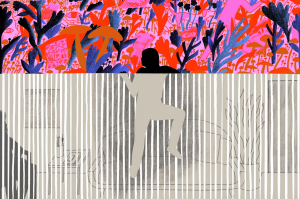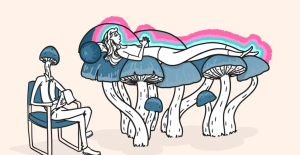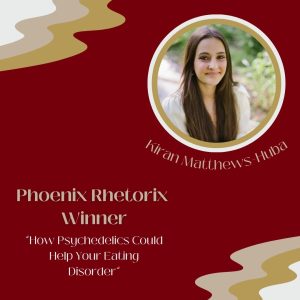- Home
- Academics
- First-Year Writing
- Phoenix Rhetorix
- 2022-23 Journal
- How Psychedelics Could Help Your Eating Disorder
How Psychedelics Could Help Your Eating Disorder
How Psychedelics Could Help Your Eating Disorder
An Article by Kiran Matthews-Huba (she/her)
With the frontier of psychedelic use in the treatment of psychiatric illnesses such as substance use and major depressive disorders, recent studies have shown their promising effect on the treatment of mainstream eating disorders.

illustration by Philip Dearest
Eating disorders are mental health issues that carry severe physical health complications and are infamous for being difficult to treat and recover from. Treatment of eating disorders has taken a multidisciplinary approach to address the disorder’s physical, psychological, and emotional aspects. Still, in recent years, experts have expressed that there could be new players in the game (think magic mushrooms and MDMA). The mind-altering power of these plants at the forefront of psychiatry brings the hopeful promise of somewhat of a “miracle drug” into the revolutionizing treatment of eating disorders. Their biggest challenge — working against skewed public opinion due to outcomes of government agendas against the tune-in, drop-out rhetoric of the 1960s.
A bit of background:
Before we dive in, it’s vital to look into the past of psychedelics and the reason for public hesitancy around their use. The American relationship between medicine and psychedelics has been tedious, with floundered progress following widespread recreational use in the 1960s and their subsequent classification as a Schedule I drug in 1967. The scheduling of psychedelics as such defined them as substances with no accepted medical use and a high potency for abuse, halting all clinical studies in one sweep until the mid-2000s. The hallucinatory substances relished a short-term relationship with psychiatry during the time when LSD, sometimes known as “acid,” was first explored and reported on as a possible aid for mood disorders and alcohol dependency. It is important to note however that before the widespread standstill, structured psychedelic use of substances such as mescaline, psilocybin (magic mushrooms), and dimethyltryptamine (DMT), had long been used in ritual healing experiences, and hold ancient grounds in many societies around the world.
Psychedelics Are Fueling a Mental Health Revolution | Bloomberg Originals
As time has lapsed and medical and neuroimaging advancements have caught up with the field, a resurgence of human psychedelic research has sprung from the ashes, and new insights bring further action into understanding pathologies. The video by Bloomberg Officials above explores this new market and a budding revolution of the mind.
According to Professor Robin Carhart-Harris, who is the Head of the Centre for Psychedelic Research at the Imperial College of London, psychedelics initiate a cascade of neurobiological changes that express at many different scales in the human brain, and ultimately climax in the relaxation of self-negative beliefs. By working at the molecular, functional, and dynamic levels of the brain, psychedelics act as a way to achieve a healthy revision of pathological dejection. Sometimes referred to as hallucinogens, the substances also alter perception and mood. They are theorized to reduce the activity of the brain’s default mode network, otherwise known as DMN, which tends to follow pathways that have already been built, no matter how negative they may be.
What this means for eating disorders today:
Eating disorders are complex and notoriously stubborn to treat as they combine features of addiction and distortions of self-perception. Often, those with eating disorders take part in self-destructive behaviors, combined with masking patterns that create confusion and high emotion in the treatment process. Once such a relationship with one’s mind is created, it becomes hard to treat with talk therapy and often cascades to cause mass disruption and destruction in the lives of those affected. While treatment approaches depend widely on the specific type of disorder being treated, from anorexia to binge eating disorder, it typically induces a combination of psychotherapy, nutrition education, medications, and medical monitoring. The problem with standard treatment is that many resources can be costly, and many disorders may lead to relapse without strict monitoring (30% chance in those with anorexia).
Given the extent of the problem, with 28 Million Americans having an eating disorder in their lifetime, it may be time to look at a wave of new triumphs that may bring in a revolutionary way to heal the human body, mind, and spirit. A recent trial launched by the University of Florida in conjunction with STOP (Study of the Treatment of Overeating Utilizing Psilocybin) reported that an oral formulation of psilocybin “demonstrated significant and prolonged improvement in primary endpoints” for all participants involved in the study. Provisional data showed that across all patients, daily binge-eating episodes were reduced by an average of 80.4% from baseline during the four-week post-dosing measurement period. In the view of many applied psychiatrists, the success of the particular 2023 binge-eating study helps raise confidence for other cases of eating disorders. Due to the similar modality of treatment methods for disordered eating across the board, the study helps validate related occurrences as a viable target for future studies under psychedelic-assisted psychotherapy.

image by JKLR on iStock
Psychedelic-assisted therapy shows immense promise for many mental health conditions and has been explored in countless clinical trials from the US to many other countries, including the UK and Australia over the last decade. Psychedelics such as psilocybin, LSD, and MDMA have been studied for their ability to improve mood, reduce anxiety, and promote emotional insight and empathy. “Psychedelics … through whatever mechanisms, seem to represent a significant improvement over the standard therapies,” says Dr. Martin Williams, executive director of Psychedelic Research in Science & Medicine at Monash University. Martin has spent almost 20 years advocating persuasively for psychedelic medical research and the clinical translation of psychedelic-assisted therapies based on scientific evidence.
How they work:
While there remain conflicts of interest and concerns about hallucinogenic therapy across the country, there is strong supportive evidence for positive psychological after-effects of a psychedelic experience that are relevant to the treatment of EDs.

Illustration by Paige Vickers
Psychedelics, such as LSD, mescaline, psilocybin, and DMT, affect our brain’s 5-HT1 family, or serotonin receptors, which are deeply involved with our prefrontal cortex. This region controls emotional regulation and reward, and in turn, some research has found that psychedelics may help address the underlying emotional issues that contribute to disordered eating. In a 2022 Interview with Pharmacy Times, a leading figure in the field of psychedelic-assisted psychotherapy, Reid Robison, explains that self-awareness is needed in the treatment of disordered eating and that it is not something that can solely be treated medicinally:
“With psychedelic medicines being ‘therapy accelerators,’ if you will, these become important tools in helping the individual see with a new perspective, and also creating more cognitive flexibility around one’s relationship with food and body- and perhaps the patterns, behaviors, and rules that they imposed on themselves around food and eating… Psychedelic medicines are more and more understood to relax the grasp that these patterns have on us by creating a, what you could call, a window of neuroplasticity- where things can be both seen more clearly and shaped.” Click here for the full 2022 interview.
With this idea of “therapy accelerators” coming into play, psychedelic drugs serve as crucial tools for assisting individuals in gaining new perspectives and increasing their cognitive flexibility in connection to their relationship with food and their bodies.

Reid Robison, MD, MBA, Chief Clinical Officer, Numinus
Small clinical studies have also been done to investigate the spiritual atmosphere psilocybin-assisted therapies could nurture in patients, which have found an increase in feelings of interconnectedness with multiple layers of themselves and a greater sense of meaning and purpose. For instance, psychedelics might assist people in better processing past trauma that may have influenced the development of an eating disorder. This may be especially helpful for those who deal with feelings of emptiness, loneliness, or a lack of purpose. “I was in a state of revelation, enthralled by what I felt in my body: not disgust or discomfort or revulsion, but utter okay-ness. That sounds like a small thing, but, for someone with an eating disorder, it was pure glory,” illustrates writer Marianne Apostolides on her own experience with therapeutic psychedelic use.
It is noteworthy, however, that along with the growing popularity of psychedelic substances, comes the growing avidity of certain individuals to use the drugs outside of supervised therapy or research. These typical users tend to be younger and more likely to experiment with mixing psychedelics with narcotics, stimulants, or alcohol, often putting themselves at risk for potential overdose issues. Harm reduction has become a major conversation by those in positions surrounding psychedelic policy.
What psychedelic-assisted eating disorder therapy could look like:
Simply put, a psychedelic-assisted therapy treatment would not be a once-in-a-lifetime, out-in-the-jungle experience but one much more monitored by professional medical providers. The general structure of an appointment would act much like going into getting prescribed medication for a chronic disorder. You would meet with a care team to discuss your concerns and goals and then set up designated appointment times and a regular schedule for psychedelic sessions spanning over a week or months. During the day of each session, you would be met with a specialist to get you set up in a safe and calming environment, where you would be administered the psychedelic and led through an integration session.

image by David Kovaluk on St. Louis Public Radio
While many treatments will look different depending on which clinic is visited and which psychedelic would be used to treat personalized disorders, psilocybin, MDMA, or DMT have the power to create a mystical experience where unvarnished truths can escape the human psyche. In guided and settled environments, there is an optimization of everything we know of psychedelics working to minimize chances for negative experiences. A single psychedelic dose could allow people to release life-long defenses, allowing them to face difficult subjects or traumatic experiences that are not easily accessible in the field of the mind. Opening up to a newfound respect for one’s body could be hugely beneficial to those suffering from destructive habits embedded in eating disorders and provide an overwhelming sense of hope for recovery.
KGW News | Febuary 2023
When these could be available:
Experts predict that treatments will likely be available within the next 18 months, and psilocybin and MDMA will likely be approved by the Federal Drug Administration (FDA) within the next two years. In 2022, The Intercept published a letter from an executive at the US Department of Health and Human Services saying that it anticipated that the FDA would approve MDMA by 2024. While a wide range of studies is still being completed to date, those in the advanced stages are gaining momentum in the world of psychiatry and the eyes of the medical field.
Even though psychedelics have been classified by experts as some of the least harmful recreational drugs, it’s important to note that the use of psilocybin and other psychedelics mentioned in this article carries certain risks. These can include the potential for adverse psychological effects and legal consequences. Without the proper setting or mindset, unmonitored psychedelic experiences could lead to health concerns such as psychiatric disorders and cardiovascular complications. Similarly, just like driving after consuming alcohol, the use of any illicit drug can make driving a car unsafe and lead to fatal car crashes or a DUI conviction. The risks associated with psychedelics are productively reduced in a restful and guided environment where participants receive structured support both during and after a therapeutic session. As such, they should only be used under the guidance of a healthcare professional and in compliance with applicable laws and regulations.
National Helpline:
If you or someone you know is struggling with depressive thoughts, or for those seeking assistance for an eating disorder call the National Suicide Prevention Lifeline at 988, or The National Eating Disorder Association Helpline which is available at 1–800–931–2237.
Author Interview: Kiran Matthews-Huba
Q. What was your inspiration for writing “How Psychedelics Could Help your Eating Disorder”? Why was this project meaningful to you?
A. The idea for the article was partly born from my own experiences with mental health and knowledge of the range of difficulties it can present in people’s lives. While researching psychedelic use throughout history for various projects in my ENG1100 class, I found more evidence of them being used and accepted within a new paradigm emerging in psychiatry. I found multiple studies being done on how psychoactive substances were being used to treat pathologies such as PTSD, addiction, depression, and anxiety disorders, among others, which led me to inquire about how they could work in the treatment of eating disorders.
Q. Is this your first time working on an article? If yes, what did that learning process look like for you? How has it changed the way you’ll work with writing in the future?
A. I have worked on similar pieces in the past as an editor at my high school newspaper and through various exploratory projects in my academic career. However, this web article was a format that was new to me. Guided by the mentorship of my ENG1100 professor, Travis Maynard, I learned about the concepts of discourse communities and genre, which changed my approach to producing this piece.
Q. In what ways did you have to think outside the box to create this piece?
A. While many studies and research articles on psychedelic-assisted therapy are available online, few dive into eating disorder treatment, and those that include it explain it in a very scientific way. I pivoted 360 degrees as I transcribed the intense vocabulary into something a wider community could connect to. The other aspect I had to work around was the fact that this type of treatment is not yet widely available to the general public and will probably shift significantly over the next few years. I had to find a way to explain what is likely coming and how people might access it without losing the facts within the research, and while also explaining the controversy around the subject in general.
Q. What roles did your peers play in developing this project?
A. While brainstorming, writing, and refining this piece, I received copious feedback from my ENG1100 class peers. No matter what stage of the process I was on, my classmates took time to read through my work, let me know what felt right to them, and gave individual perspectives, which I relied on in creating a web article that the public could easily understand. I am grateful for their insights and willingness to share their own struggles with me.
Q. What advice would you give to students who are currently enrolled in ENG 1100, might want to complete a similar project, or are interested in publishing in Phoenix Rhetorix?
A. I advise those looking to complete a similar project to take full advantage of both peers and their professor in ENG1100. Getting feedback is crucial in making an impactful piece and fosters a sense of community during a transitional time in students’ lives. I also cannot stress enough how important it is to communicate with your professor to find a topic that inspires your imagination and passion.
ENG 1100 Faculty Interview: Travis Maynard (he/him)
Q. During your ENG 1100 class, what about Kiran’s piece stood out to you?
A. As you might imagine from looking at the title of Kiran’s piece, I was struck by the unique nature of the topic and that the piece is exploring the cutting edge of therapeutic research.
Q. How do you see Kiran’s piece contributing to Elon’s ongoing conversations regarding diversity, equity, and inclusion?
A. I believe the piece addresses diversity, equity, and inclusion on two fronts. First, female-identifying individuals are disproportionately affected by disordered eating, and second, the piece broadens the scope of DEI to include those with disordered eating.
Q. How did you see Kiran’s writing evolve over the course of the semester?
A. Kiran’s work throughout the semester took a really interesting journey. Her first project in the course examined the rhetorical evolution of the Grateful Dead’s skull logo, and given the Grateful Dead’s strong connections to psychedelics, the topic for this article seemed like a pretty natural transition for Kiran to make.
Q. How did Kiran use creativity when working on this project? Did she try anything you’ve never seen before?
A. In ten years of teaching, I’ve gotten a lot of papers about legalizing marijuana, but I’ve never gotten one about the therapeutic uses of psychedelics!